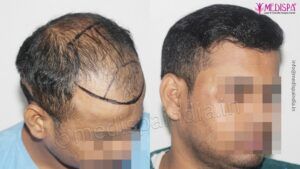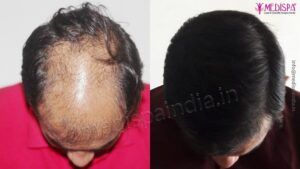
A hair transplant is a significant choice that necessitates careful consideration. Consequently, it is common to have numerous uncertainties regarding the procedure prior to making a decision. There are several essential factors to understand before proceeding with a hair transplant, as various misconceptions may either deter you from the decision or lead to unrealistic expectations about the outcome.
The popularity of hair transplant in Jaipur as a solution for hair loss has surged, making these procedures widely accessible. The hair transplant cost in Jaipur has notably decreased due to heightened competition within the industry. However, many clinics employ vague terminology to attract clients, which can result in dissatisfaction with the results.
Therefore, it is imperative to be informed about certain aspects before undergoing the treatment. At Medispa clinics, transparency and honest guidance are prioritized, as they are vital for achieving satisfactory outcomes alongside excellent results. Dr. Suneet Soni is a highly skilled hair transplant surgeon who emphasizes the importance of thoroughly explaining the procedure and establishing realistic expectations prior to its execution. As one of the leading hair transplant centers in India, this approach has proven to be highly effective.
Hair transplant cosmetic surgery
Hair transplant is a minimally invasive surgical procedure aimed at restoring hair by relocating hair follicles from a donor site, chosen based on the density of available hair, to a bald area on the recipient’s scalp. This cosmetic procedure demands a high level of precision and requires significant expertise and skill.
Several fundamental aspects to consider regarding hair transplant surgery include:
- It is not a regenerative treatment capable of restoring lost hair follicles; rather, it is a restorative procedure that merely relocates existing follicles from one area to another.
- Immediate results are not achievable; patients typically must wait several months, often up to a year, to see the full effects of hair growth.
- The procedure does not prevent ongoing hair loss, which may still occur in areas surrounding the transplanted follicles. However, if the transplanted hair is harvested and implanted correctly, it can remain permanent for the individual’s lifetime.
- Advances in technology have enabled the procedure to yield permanent and natural-looking results, replicating a hairline that closely resembles the individual’s original hairline.
- The hair transplant technique is a precision-based surgery that carries potential complications and risks if not executed by a qualified professional.
Phases of hair transplant process
It is essential for you to familiarize yourself with the basic technique of hair transplantation; thus, a thorough comprehension of the procedure’s complexities is vital. In the subsequent section, we will examine the hair transplantation process in depth. The procedure consists of several stages.
- Planning: The initial phase focuses on tailoring the operation to address the unique requirements of each patient. This planning stage considers the extent of hair loss, the density of hair in the donor area, and the patient’s desired outcomes. Once the planning is complete, laboratory tests are conducted to confirm the patient’s medical suitability.
- Extraction phase: The initial stage of the extraction or harvesting process involves marking a preliminary hairline. Subsequently, hair follicles are extracted from the designated donor area utilizing FUT and FUE hair transplant methods. The selection of the appropriate hair transplant technique is influenced by various factors, including the location and severity of baldness, the desired hair density, and the preferences of the patient.
- Slitting phase: In the slitting phase, the recipient site is meticulously prepared in accordance with the established hairline design. It is crucial to ensure the correct angulation and arrangement to achieve a natural appearance in the hair transplant.
- Transplantation phase: During the hair transplant procedure, the harvested hair follicles are meticulously inserted into the incisions created by the surgeon. A team of highly skilled professionals employs magnification tools to guarantee the accurate placement of the hair follicles. The entire procedure is conducted with meticulous attention to detail, prioritizing the aesthetic objectives of the patient.
The duration of a hair transplant procedure generally varies between 4 to 9 hours, depending on the expertise of the surgeon and the extent of hair loss. In cases of considerable baldness, multiple sessions may be necessary to achieve the desired results. It is crucial to choose a physician who possesses advanced training and extensive experience in hair transplant surgery. Selecting a reputable clinic with a qualified surgeon is vital for ensuring a successful outcome. For a dependable and exceptional hair transplant experience, it is advisable to schedule a consultation at the Medispa hair transplant clinic situated in Delhi or Jaipur.
Methods to perform hair transplant
There are two main methods utilized for hair transplantation: FUT and FUE. The FUT technique, often referred to as the strip method, involves the removal of a narrow strip from the donor site. This strip is then segmented into smaller pieces, with each hair follicle being carefully extracted under high magnification. Once the donor area is sutured, the extracted follicles are meticulously implanted into the designated balding regions. On the other hand, the FUE technique focuses on the individual extraction of hair follicles using a punch-like instrument. This tool is inserted into the scalp to retrieve each follicle, which is subsequently transplanted into the targeted bald spots. The FUT method can yield approximately 3,000 to 3,500 hair follicles and is generally recommended for individuals with significant hair loss. In contrast, the FUE method can extract around 2,000 to 2,500 hair follicles and is typically more appropriate for those in the early stages of hair loss or for facial hair transplants.
Expectations from hair transplant procedure
Hair transplantation is classified as an elective procedure; however, it may not be appropriate for all individuals. A significant determinant of the procedure’s success is the availability of hair follicles in the donor region. It is vital that this area has sufficient density to promote effective hair growth. The expected outcomes are closely linked to the quantity of hair follicles that can be transplanted. It is important to engage in an initial consultation with your physician to discuss your expectations regarding the hair transplant, as a comprehensive evaluation will allow the doctor to offer valuable insights into possible results. Should you have any inquiries or require trustworthy information about hair transplants, we recommend visiting the Medispa clinic in Delhi or Jaipur for professional advice and outstanding hair loss treatments.







